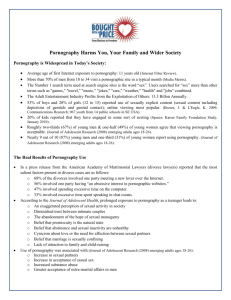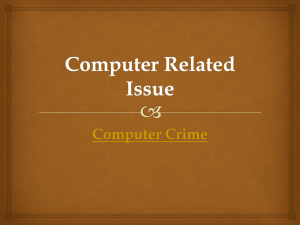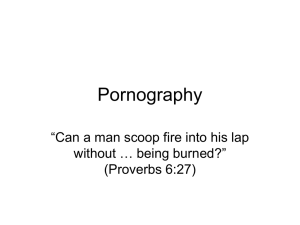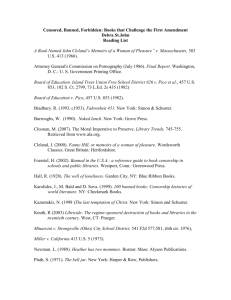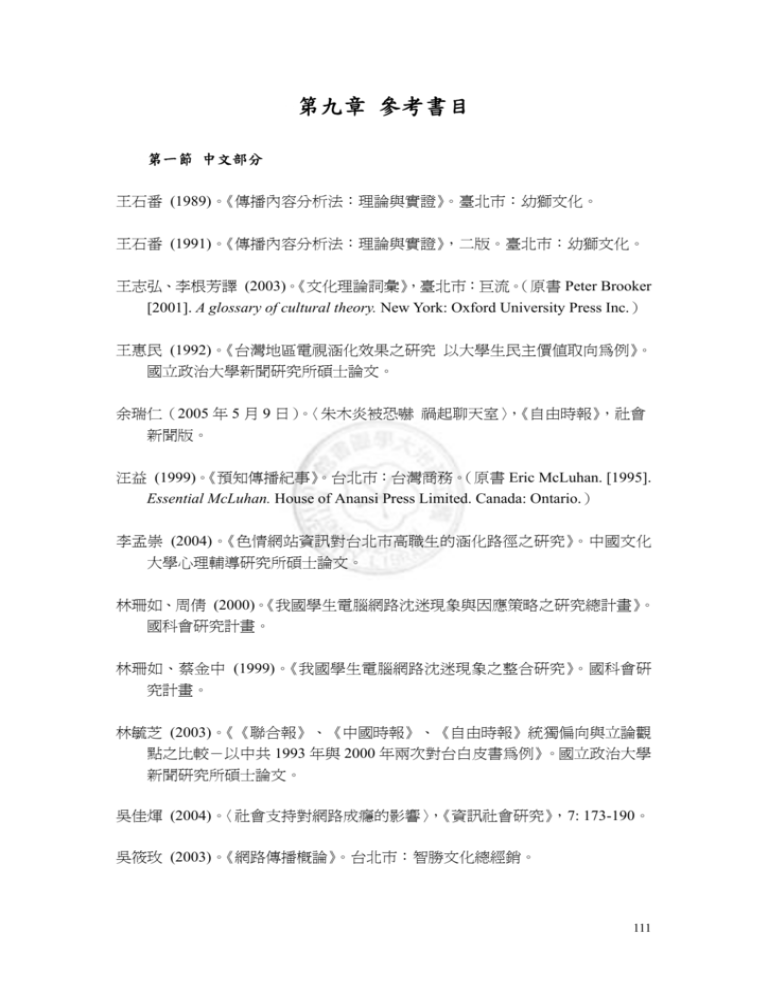
第九章 參考書目
第一節 中文部分
王石番 (1989)。《傳播內容分析法:理論與實證》。臺北市:幼獅文化。
王石番 (1991)。《傳播內容分析法:理論與實證》,二版。臺北市:幼獅文化。
王志弘、李根芳譯 (2003)。
《文化理論詞彙》
,臺北市:巨流。
(原書 Peter Brooker
[2001]. A glossary of cultural theory. New York: Oxford University Press Inc.)
王惠民 (1992)。《台灣地區電視涵化效果之研究 以大學生民主價值取向為例》。
國立政治大學新聞研究所碩士論文。
余瑞仁(2005 年 5 月 9 日)。〈朱木炎被恐嚇 禍起聊天室〉,《自由時報》,社會
新聞版。
汪益 (1999)。
《預知傳播紀事》
。台北市:台灣商務。
(原書 Eric McLuhan. [1995].
Essential McLuhan. House of Anansi Press Limited. Canada: Ontario.)
李孟崇 (2004)。《色情網站資訊對台北市高職生的涵化路徑之研究》。中國文化
大學心理輔導研究所碩士論文。
林珊如、周倩 (2000)。
《我國學生電腦網路沈迷現象與因應策略之研究總計畫》。
國科會研究計畫。
林珊如、蔡金中 (1999)。《我國學生電腦網路沈迷現象之整合研究》。國科會研
究計畫。
林毓芝 (2003)。
《《聯合報》、《中國時報》、《自由時報》統獨偏向與立論觀
點之比較-以中共 1993 年與 2000 年兩次對台白皮書為例》。國立政治大學
新聞研究所碩士論文。
吳佳煇 (2004)。〈社會支持對網路成癮的影響〉,《資訊社會研究》,7: 173-190。
吳筱玫 (2003)。《網路傳播概論》。台北市:智勝文化總經銷。
111
邱建明 (2004)。《結合影像與文字辨識的網路色情過濾》。國立中央大學資訊工
程研究所碩士論文。
陳金英 (2004)。
〈網路使用習性、網路交友期望與社交焦慮之分析〉
,
《資訊社會
研究》,7: 111-146。
黃心怡、蘇建華 (2005)。
〈網路虛擬社群之研究先驅〉
,
《資訊社會研究》
,9: 1-88。
黃登榆 (1996)。《網路色情現象初探:從閱聽人的角度談起》。國立政治大學碩
士論文。
翁秀琪 (1993)。《大眾傳播理論與實證》。台北市:三民。
游美惠 (1993)。
〈台灣色情海報的解讀分析〉
,
《台灣社會研究季刊》
,14: 77-100。
張寶芳 (2005)。〈網路媒體與傳播教育〉,《傳播研究簡訊》,43: 9-11。
趙文琦譯 (2005)。
《異國情色大不同—性愛人類學》
,臺北市:書林。
(原書 DeWight
R. Middleton[2002]. Exotics and Erotics: Human Cultural and Sexual Diversity.
Prospect Heights, IL: Waveland Press.)
蔡美瑛 (1998)。〈性別與網路座談會〉,《新聞學研究》,64: 183-194。
劉慧雯 (2003)。
《特新大眾傳播理論》
。臺北市:韋伯文化。
(原書 Denis McQuail.
Mass Communication Theory: An Introduction, 4th ed.)
羅文輝 (2000)。
〈性策略理論、性別、第三人效果與支持限制色情媒介〉
,
《新聞
學研究》,63: 201-222。
羅燦瑛 (1996)。
〈強暴迷思與兩性平等〉
,謝臥龍(主編)
。
《兩性、文化與社會》,
頁 267-286。台北:心理。
羅燦瑛 (1998)。〈性暴力的文化再現:港台強暴電影的文本分析〉,《新聞學研
究》,57: 159-190。
第二節 英文部分
Allen, M., Emmers, T., Gebhardt, L., & Giery, M. A. (1995). Exposure to
pornography and acceptance of rape myths. Journal of Communication, 45(1),
112
5-26.
Baker, P. (1992). Maintaining male power: Why heterosexual men use pornography.
In Itzin, C. (Ed.), Pornography: Women, violence and civil liberties (pp.
124-144). New York: Oxford University Press Inc.
Bandura, A. (1978). Social learning theory of aggression. Journal of Communication,
28(3), 12-29.
Bell, D., Loader, B. D., Pleace, N., & Schuler, D. (2004). Cyberculture: The key
concepts. London: Routledge.
Bryant, J., Carveth, R. A., & Brown, D. (1981). Television viewing and anxiety: An
experimental examination. Journal of Communication, 31(1), 106-119.
Buckingham, D. (1998). Children and television: a critical overview of the research.
In Dickinson, R. Harindranath, R., & Linne, O. (Eds.), Approaches to audiences:
A reader (pp. 131-146). New York: Oxford University Press Inc.
Cohen, J. & Weimann, G. (2000). Cultivation revisited: some genres have some effects
on some viewers. Communication Reports, 13 (2), 99-114.
Dickinson, R. (1998). Modernity, consumption and anxiety: television audiences and
food choice. In Dickinson, R., Harindranath, R., & Linne, O. (Eds.), Approaches
to Audiences: A Reader (pp. 257-269). New York: Oxford University Press Inc.
Dines, G., & Jensen, R. (2004). Pornography and media: Toward a more critical
analysis. In M. S. Kimmel and R. F. Plante (Eds.), Sexualities: Identity,
behaviors, and society (pp. 369-380). New York: Oxford University Press.
Doob. A. N., & Macdonald, G. E. (1979). Television viewing and fear of victimisation:
Is the relationship causal? Journal of Personality and Social Psychology, 37,
170-179.
Dworkin, A. (1989). Pornography: Men possessing women. USA: Dutton.
Einsiedel, E. F. (1992). The experimental research evidence: Effects of pornography
on the ‘average individual.’ In Itzin, C. (Ed.), Pornography: Women, violence
113
and civil liberties (pp. 248-283). New York: Oxford University Press Inc.
Feilitzen, C. V. (1998). Media violence – four research perspectives. In Dickinson, R.,
Harindranath, R. & Linne, O. (Eds.), Approaches to Audiences: A Reader (pp.
88-104). New York: Oxford University Press Inc.
Flood, M. (2007). Exposure to pornography among youth in Australia. Journal of
Sociology, 43 (1), 45-60.
Gauntlett, D. (1998). Ten things wrong with the ‘effects’ model. In Dickinson, R.
Harindranath, R., & Linne, O. (Eds.), Approaches to audiences: A reader (pp.
120-131). New York: Oxford University Press Inc.
Gerbner, G. (1990). Epilogue: Advancing on the path of righteousness (Maybe). In
Signorielli, N., & Morgan, M. (Eds.), Cultivation analysis: New directions in
media effects research (pp. 249-262). Berkeley Hill, CA: Sage.
Gerbner, G., & Gross, L. (1976). Living with television: The violence profile. Journal
of Communication, 26(2), 173-199.
Gerbner, G., Gross, L., Eleey, M., Jackson-Beeck, M., Jeffries-Fox, S., & Signorielli,
N. (1977a). TV violence profile no. 8: The highlights. Journal of Communication,
27(2), 171-180.
Gerbner, G., Gross, M., Jackson-Beeck, M., Jeffries-Fox, S., & Signorielli, N. (1978).
Cultural indicators: Violence profile no. 9. Journal of Communication, 28(3),
176-207.
Gerbner, G., Gross, L., Morgan, M., & Signorielli, N. (1979). On Wober’s ‘Televised
violence and paranoid perception: The view from Great Britain.’ Public
Opinion Quarterly, 43(1), 123-124.
Gerbner, G., Gross, L., Morgan, M., & Signorielli, N. (1980a). Some additional
comments on cultivation analysis. Public Opinion Quarterly, 44(3), 408-410.
Gerbner, G., Gross, L., Morgan, M., & Signorielli, N. (1980b). The ‘mainstreaming’
of America: Violence profile no. 11. Journal of Communication, 30(3), 10-29.
114
Gerbner, G., Gross, L., Morgan, M., & Signorielli, N. (1994). Growing up with
television: The cultivation perspective. In Bryant, J., & Zillmann, D. (Eds.),
Media effects (pp. 17-41). Hillsdale, NJ: Erlbaum.
Hald, G. M. (2006). Gender differences in pornography consumption among young
heterosexual Danish adults. Arch Sex Behav, 35, 577–585.
Hardy, B. W., & Scheufele, D. A. (2005). Examining differential gains from internet
use: Comparing the moderating role of talk and online interactions. Journal of
Communication, 55(1), 71-85.
Itzin, C. (1992). Entertainment for men: What it is and what it means. In Itzin, C.
(Ed.), Pornography: Women, violence and civil liberties (pp. 27-54). New York:
Oxford University Press Inc.
Kapppeler, S. (1992). Pornography: The representation of power. In Itzin, C. (Ed.),
Pornography: Women, violence and civil liberties (pp. 88-101). New York:
Oxford University Press Inc.
Kellner, D. (1998). Toward a critical theory of television. In Dickinson, R.
Harindranath, R., & Linne, O. (Eds.), Approaches to Audiences: A Reader (pp.
36-50). New York: Oxford University Press Inc.
Koch, T. (1996). The message is the medium: online all the time for everyone.
Westport, CT/London: Praeger.
Kwak, H., Zinkhan, G. M., & Dominick, J. R. (2002). The moderating role of gender
and compulsive buying tendencies in the cultivation effects of TV show and TV
advertising: A cross cultural study between the United States and South Korea.
Media Psychology, 4(1), 77-111.
Lam, C. B., & Chan, D. K.-S. (2007). The use of cyberpornography by young men in
Hong Kong: Some psychosocial correlates. Arch Sex Behav, 36, 588-598.
Lee, B., & Tamborini, R. (2005). Third-person effect and internet pornography: The
influence of collectivism and internet self-efficacy. Journal of Communication,
55(2), 292-310.
115
Linne, O., & Wartella, E. (1998). Research about violence in the media: different
traditions and changing paradigms. In Dickinson, R., Harindranath, R., & Linne,
O. (Eds.), Approaches to Audiences: A Reader (pp. 104-120). New York: Oxford
University Press Inc.
Lo, V. H., & Wei, R. (2005). Exposure to internet pornography and Taiwanese
adolescents’ sexual attitudes and behavior. Journal of Broadcasting & Electronic
Media, 49(2), 221-237.
Marien, M. (1996). New communications technology: A survey of impacts and issues.
Telecommunications Policy, 20(5), 375-387.
McCombs, M. (1998). News influence on our pictures of the world. In Dickinson, R.,
Harindranath, R., & Linne, O., Approaches to audiences: A reader (pp. 25-36).
New York: Oxford University Press Inc.
McLuhan, E. (1995). Essential McLuhan. House of Anansi Press Limited. Canada:
Ontario.
McQuail, D. (1998). With the benefit of hindsight: reflections on uses and
gratifications research. In Dickinson, R. Harindranath, R., & Linne, O. (Eds.),
Approaches to Audiences: A Reader (pp. 151-166). New York: Oxford University
Press Inc.
Mehta, M. D., & Plaza, D. E. (1997). Pornography in cyberspace: an exploration of
what’s in Usenet, in Kiesler, S. (Eds.), Culture of the Internet. NJ: Lawrence
Earlbaum Associates.
Morgan, M. (1990). International cultivation analysis. In Signorielli, N., & Morgan,
M., Cultivation Analysis: New Directions in Media Effects Research (pp.
225-248). Berkeley Hill, CA: Sage.
Morgan, M., & Signorielli, N. (1990). Cultivation analysis: Conceptualization and
methodology. In Signorielli, N., & Morgan, M. (Eds.), Cultivation Analysis: New
directions in media effects research (pp. 13-34). Berkeley Hill, CA: Sage.
Olliges, R. (1996). The Social impact of computer-based communications.
Communication Research Trends, 16, 3-28.
116
Oswell, D. (2006). When images matter: Internet child pornography, forms of
observation and an ethics of the virtual. Information, Communication & Society,
9(2), 244-266.
Palmer, C. E. (1979). Pornographic comics: A content analysis. The journal of Sex
Research, 15, 285-298.
Perse, E. M. (1990). Cultivation and involvement with local television news. In
Signorielli, N., & Morgan, M. (Eds.), Cultivation analysis: New directions in
media effects research (pp. 51-69). Berkeley Hill, CA: Sage.
Peter, J. & Valkenburg, P. M. (2006). Adolescents’ exposure to sexually explicit online
material and recreational attitudes toward sex. Journal of Communication, 56(4),
639-661.
Peter, J., & Valkenburg, P. M. (2006). Adolescents' exposure to sexually explicit
material on the Internet. Communication Research, 33 (2), 178-204.
Peter, K., & Smith, M. A. (1999). Communities in cyberspace. In Smith, M. A., &
Kollock, P. (Eds.), Communities in Cyberspace (pp. 3-25). London: Routledge.
Potter, W. J. (1993). Cultivation theory and research: A conceptual critique. Human
Communication Research, 19, 564-601.
Preston, E. H. (1990). Pornography and the construction of gender. In Signorielli, N.,
& Morgan, M. (Eds.), Cultivation analysis: New directions in media effects
research (pp. 107-122). Berkeley Hill, CA: Sage.
Reimer, B., & Rosengren, K. E. (1990). Cultivated viewers and readers: A life-style
perspective. In Signorielli, N. & Morgan, M. (Eds.), Cultivation analysis: New
directions in media effects research (pp. 181-206). Berkeley Hill, CA: Sage.
Romer, D., Jamieson, K. H., & Aday, S. (2003). Television news and the cultivation of
fear of crime. Journal of Communication, 53(1), 88-104.
Russell, D. E. H. (1992). Pornography and rape: A causal model. In Itzin, C., (Eds.),
Pornography: Women, violence and civil liberties (pp. 310-349). New York:
117
Oxford University Press Inc.
Signorielli, N. (1990). Television’s mean and dangerous World: A continuation of the
cultural indicators perspective. In Signorielli, N., & Morgan, M. (Eds.),
Cultivation analysis: New directions in media effects research (pp. 85-106).
Berkeley Hill, CA: Sage.
Sweet, C. (1992). Pornography and addiction: A political issue. In Itzin, C. (Ed.),
Pornography: Women, violence and civil liberties (pp. 179-200). New York:
Oxford University Press Inc.
Topscott, D. (1998). Growing up digital: The rise of the net generaation. New York :
McGraw-Hill.
Walther. J. B. (1996). Computer-mediated communication: impersonal, interpersonal
and hyperpersonal interaction. Communication Research, 23(1), 3-43.
Walther. J. B. (1992). Interpersonal effects in computer-mediated interaction: a
relational perspective. Communication Research, 19(1), 52-90.
Weaver, J. (1992). The social science and psychological research evidence: perceptual
and behavioural consequences of exposure to pornography. In Itzin, C.,
Pornography: Women, violence and civil liberties (pp. 284-309). New York:
Oxford University Press Inc.
Williams, D. (2006). Virtual cultivation: Online worlds, offline perceptions. Journal
of Communication, 56, 69–87.
Wilson, B. J., & Smith, S. L. (1998). Children’s responses to emotional portrayals on
TV. In Andersen, P. A. & Guerrero, L. K. (Eds.), Handbook of communication
and emotion (pp. 554-569). London: Academic Press Limited.
Winick, C (1985). A content analysis of sexually explicit magazines sold in an adult
bookstore. The Journal of Sex Research, 21, 206-210.
Wyre, R. (1992). Pornography and sexual violence: Working with sex offenders. In
Itzin, C. (Ed.), Pornography: Women, violence and civil liberties (pp. 236-247).
New York: Oxford University Press Inc.
118
Yaffe, M. (1982). Therapeutic uses of sexually explicit material. In Yaffe, M., &
Nelson, E. C. (Eds.), The influence of pornography on behaviour (pp. 119-150).
Academic Press Inc.: London.
Yellowlees, P. M., & Marks, S. (2005). Problematic internet use or internet addiction?
Computers in Human Behavior, 23(3), 1447–1453.
Young, K. S. (1996). Internet addiction: The emergence of a new clinical disorder.
Paper presented at the 104th annual meeting of American Psychological
Association, Toronto, Canada.
Young, K. S. (1996). Psychology of computer use: XL. Addictive use of the Internet:
A case that breaks the stereotype. Psychological-Reports, 79(3), 899-902.
第三節 網路部分
Answers.com. Retrieved October 30, 2005, from
http://www.answers.com/topic/pornography
Burns, R. J. (1999). An on-line study of the uses and gratifications of internet
pornography. AEJMC Conference Papers. Retrieved November 9, 2005, from
http://list.msu.edu/cgi-bin/wa?A2=ind9909b&L=aejmc&T=0&F=&S=&P=8205
Conner, R. C. (2004). Classic spam: Dialer hell. Rick’s Spam Digest. Retrieved
November 9, 2005, from
http://www.rickconner.net/spamweb/spam_dirtypics.html
Cooper, A., Scherer, C. R., Boies, S. C., & Barry L. Gordon (1999).
Internet sexuality: Pleasure or pathology? Retrieved November 11, 2007, from
http://www.selfhelpmagazine.com/articles/sex/netsex.html
Diamond, M., & Uchiyama, A. (1999). Pornography, rape and sex crimes in Japan.
International Journal of Law and Psychiatry, 22(1), 1-22. Retrieved November 7,
2005, from
http://www.hawaii.edu/PCSS/online_artcls/pornography/prngrphy_rape_jp.html
e21times.com (2000)。
〈美國有 20 萬人沉迷網路色情〉
。上網日期:2005 年 10 月
119
25 日,取自 http://e21times.com/ei/fortune.asp?rtid=948&sid=2
Erotic art in Pompeii (n.d.). Retrieved October 30, 2005, from
http://en.wikipedia.org/wiki/Erotic_art_in_Pompeii
Harmon, D., & Boeringer, S. B. (1997). A content analysis of internet-accessible
written pornographic depictions. Electronic Journal of Sociology. Retrieved
November 7, 2005, from
http://www.sociology.org/content/vol003.001/boeringer.html
Jensen, R. (2004). Pornography and sexual violence. Retrieved September 9, 2007,
from http://0rz.tw/3f32P
Kapor, M. (1996). Where is the digital highway really heading? Retrieved October 26,
2005, from
http://www.hotwired.com/wired/1.3/features/kapor.on.nii.html
LaRue, J. (2003). Let’s end 'victims of pornography' month. Concerned women for
America. Retrieved October 25, 2005, from
http://www.cwfa.org/articledisplay.asp?id=3838&department=LEGAL&category
id=pornography
Lo, V. H., & Wei, R. (2000). Third-person effect, gender and pornography on the
internet. Paper submitted to the research division of The Broadcasting Education
Association (BEA) at the 45th Annual Conference of BEA in Las Vegas, April
7-11, 2000. Retrieved November 9, 2005, from
http://66.102.7.104/search?q=cache:RZ1dJHbX5E0J:www.beaweb.org/bea2000/
papers/lo%26wei.pdf+pornography%2Btable%2Bcontent+analysis&hl=zh-TW
Madden, M. (2006). Reports: Internet evolution. Internet penetration and impact.
Retrieved October 7, 2007, from
http://www.pewinternet.org/PPF/r/182/report_display.asp
McCosker, C. (2004). Internet censorship - Access to pornography (Redirected from
Internet Pornography Censorship: Access). Retrieved November 9, 2005, from
http://wiki.media-culture.org.au/index.php/Internet_Pornography_Censorship:_A
ccess
120
Okwu, M. (2006). Might as well face it, he’s addicted to net porn. Retrieved
November 05, 2007, from
http://www.msnbc.msn.com/id/11609937/
Parr, B. (2002). Drugs. Gambling. Terrorism. Child pornography. … More accessible
than ever! Media savvy: Barry Parr’s daily analysis of networked media news
and research. Retrieved November 9, 2005, from
http://mediasavvy.com/archives/2002_08.shtml
Plato, J. (1999). Child pornography on the internet. Educator's guide to computer
crime and technology misuse. Retrieved November 7, 2005, from
http://lrs.ed.uiuc.edu/wp/crime/childporn.htm
Rainie, L., & Horrigan, J. (2005). A decade of adoption: How the internet has woven
itself into American life. Retrieved October 26, 2005, from
http://www.pewinternet.org/PPF/r/148/report_display.asp
Rheingold, H. (1993). The virtual community (the electronic version). Retrieved
November 27, 2005, from http://www.rheingold.com/vc/book/intro.html
Rimm, M. (1995). Marketing pornography on the information superhighway: A
survey of 917,410 images, descriptions, short stories, and animations
downloaded 8.5 million times by consumers in over 2,000 cities in forty
countries, provinces, and territories. Retrieved November 7, 2005, from
http://www.sics.se/~psm/kr9512-001.html
Ropelato, J. (n.d.). Internet Filter Review. Retrieved September 29, 2007, from
http://internet-filter-review.toptenreviews.com/internet-pornography-statistics.ht
ml#time
Ross, M. E. (1990). Censorship or education? Feminist views on pornography.
Christian Century, 244-246. Retrieved November 7, 2005, from
http://www.religion-online.org/showarticle.asp?title=759
Soanes, C., & Stevenson, A. (2004). The concise Oxford English dictionary. Oxford
University Press. Oxford Reference Online. Retrieved October 30, 2005, from
http://www.oxfordreference.com/views/ENTRY.html?entry=t23.e43833&srn=2
&ssid=568295203#FIRSTHIT
121
Spink, A., Jansen, B. J., Wolfram, D., & Saracevic, T. (2002). From e-Sex to
e-commerce: Web search changes. Retrieved November 8, 2005, from
http://66.102.7.104/search?q=cache:od27z_t80K0J:ist.psu.edu/faculty_pages/jjan
sen/academic/pubs/ieee_computer.pdf+pornography%2Btable%2Bcontent+analy
sis&hl=zh-TW
The American internet user survey: New survey highlights (1996). Retrieved October
26, 2005, from
http://etrg.findsvp.com/features/newinet.html
The Oxford American dictionary of current English (1999). Oxford University Press.
Oxford Reference Online. Retrieved October 30, 2005, from
http://www.oxfordreference.com/views/ENTRY.html?subview=Main&entry=t21.
e23648
Thornburgh, D., & Lin, H. (2002). Youth, pornography, and the Internet. Issues online.
Retrieved November 9, 2005, from
http://www.issues.org/issues/20.2/thornburgh.html
Toffler, A. (1996). Shock wave (Anti) warrior. Retrieved October 27, 2005, from
http://www.hotwired.com/wired/1.5/features/toffler.html
UT 網 際 空 間 網 站 聯 盟 。 上 網 日 期 : 2005 年 10 月 29 日 , 取 自
http://link.f1.com.tw/?31
World encyclopedia, OXFORD Reference ONLINE. Retrieved October 30, 2005,
from
http://www.oxfordreference.com/views/ENTRY.html?entry=t105.e9270&srn=1&
ssid=568295203#FIRSTHIT
台灣網路資訊中心 TWNIC(2006 年 09 月 01 日)
。
〈台灣上網人口逾 1,500 萬人,
上網率達 67.69%〉。上網日期:2007 年 08 月 28 日,取自
http://investintaiwan.nat.gov.tw/zh-tw/news/200609/2006090101.html
台灣網路資訊中心 TWNIC、NetValue Co. Ltd. (2002)。
〈台灣網際網路使用環境
及 行 為 調 查 〉。 上 網 日 期 : 2005 年 10 月 12 日 , 取 自
http://www.twnic.net.tw/total/TWNIC_Rev.doc
122
行政院國家資訊通信發展推動小組(2003 年 8 月 15 日)
。
〈2003 年 6 月底止台灣
上網人口〉。上網日期:2005 年 10 月 12 日,取自
http://www.nici.nat.gov.tw/content/application/nici/general/guest-cnt-browse.php
?grpid=5&vroot=&cntgrp_ordinal=00060004&cnt_id=235&listtype=
李雅萍(2001 年 6 月 6 日)
。
〈交通部:我國上網人口數達 834 萬人〉
。上網日期:
2005 年 10 月 12 日,取自
http://www.find.org.tw/0105/news/0105_news_disp.aspx?news_id=1506
李雅萍(2001 年 6 月 6 日)。〈我國寬頻用戶數達 387 萬戶〉。上網日期:2005
年 10 月 29 日,取自
http://www.find.org.tw/0105/howmany/howmany_disp.asp?id=118
批踢踢實業坊 (ptt.cc)。上網日期:2005 年 10 月 12 日,取自 bbs:// 218.165.223.212
終止童妓協會(無日期)。〈網路大冒險〉。上網日期:2005 年 11 月 24 日,
取自 http://www.web547.org.tw/danger3.htm。
終止童妓協會 (2002)。〈五大中文色情網站監看報告〉。上網日期:2007 年 10
月 22 日,取自 http://www.web547.org.tw/report3.htm。
終止童妓協會 (2002)。〈色情電子郵件網路問卷調查報告〉
。上網日期:2007 年
11 月 01 日,取自 http://www.web547.org.tw/report5.htm。
終止童妓協會 (2005)。〈影音寬頻成人特區 色情不打烊〉。上網日期:2007 年
10 月 22 日,取自 http://www.web547.org.tw/report14.htm。
陳嘉賓 (2004)。〈網路色情之初探討〉,《網路社會學通訊期刊》,36。上網日
期:2005 年 10 月 12 日,取自
http://mail.nhu.edu.tw/~society/e-j/36/36-36.htm
葉宏達(無日期)。〈未成年人上網接觸不當資訊之防治策略探討〉。上網日期:
2005 年 10 月 16 日,取自 http://www.nhltc.edu.tw/~honda/antisex/
張漢宜 (2001)。
〈情色網站〉,《e 天下》,9。上網日期:2005 年 10 月 29 日,
取自 http://www.cwk.com.tw/cw/search/view1.asp
楊艾俐 (1999)。〈亞洲應有自己的媒體觀〉,《天下雜誌》,213。上網日期:
123
2005 年 10 月 29 日,取自 http://www.cwk.com.tw/cw/search/view1.asp
楊艾俐 (2000)。〈是美麗新世界 還是一根虛弱的蘆葦〉,《天下雜誌特刊》,
029。上網日期:2005 年 10 月 29 日,取自
http://www.cwk.com.tw/cw/search/view1.asp
資策會推廣服務處 (1998)。〈全球上網人口〉。上網日期:2005 年 10 月 12 日,
取自
http://www.find.org.tw/observation/how_many/global/user/199811/globaluser.ht
ml
《傳播學生鬥陣電子報》(2005 年 11 月 21 日)。〈本週媒大事:1.美情色產業搶
攻可攜式小螢幕〉,第 278 期。
《傳播學生鬥陣電子報》
(2005 年 11 月 28 日)
。
〈飆網無國界—淺談網路內容管
制政策與反思〉,第 279 期。
《傳播學生鬥陣電子報》
(2006 年 02 月 07 日)
。
〈『限制級網站!』〉
,第 289 期。
錢玉芬、楊可凡、陳盈珊 (2000)。《網路色情訊息所建構的性世界》。上網日
期:2007 年 09 月 07 日,取自 http://0rz.tw/6731K
124


